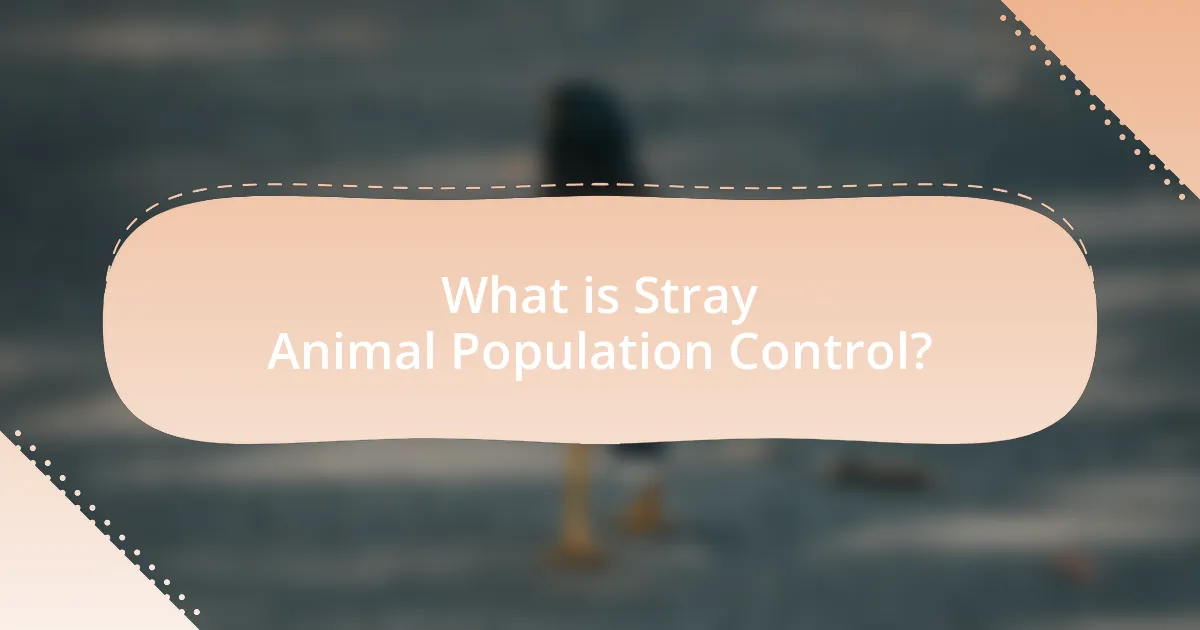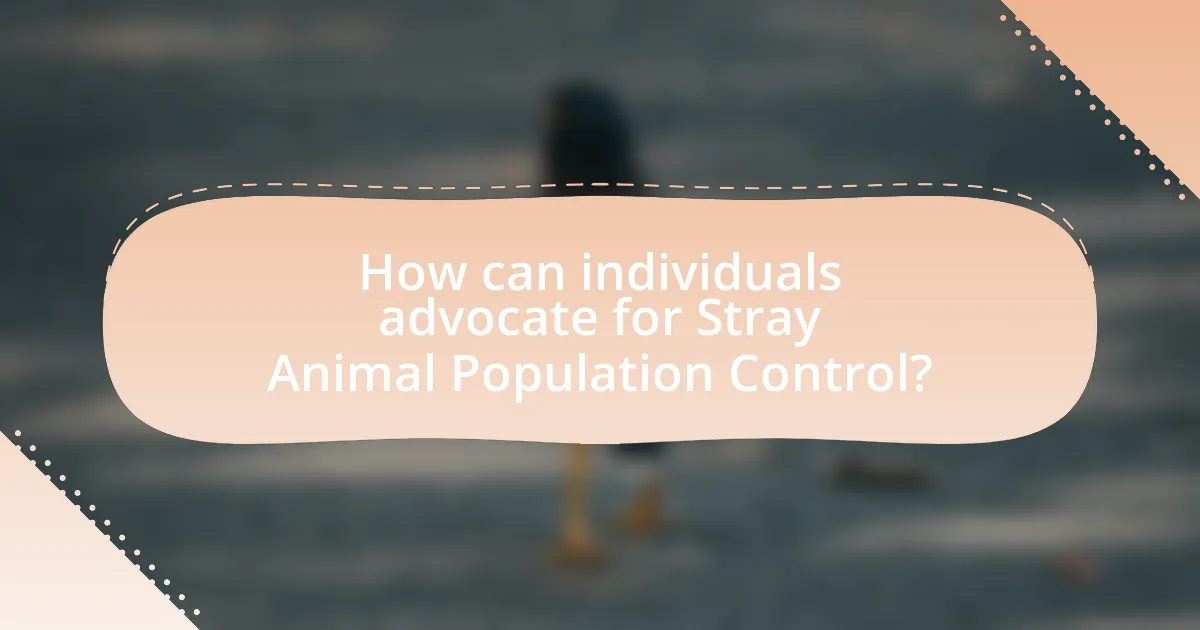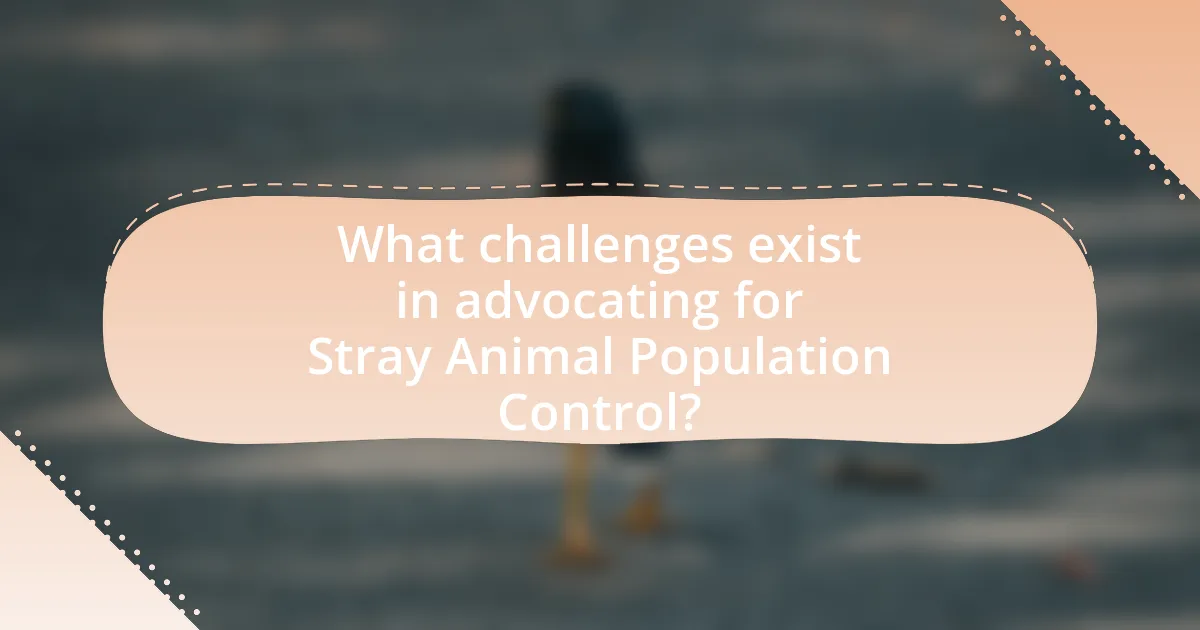Stray Animal Population Control encompasses various methods aimed at managing and reducing the number of stray animals, primarily through spaying and neutering, adoption programs, and public education. Effective control is crucial for promoting animal welfare, reducing disease transmission, and alleviating pressure on shelters. The article outlines the importance of these control measures, the consequences of uncontrolled populations, and the roles of shelters and rescues. It also discusses advocacy strategies, community engagement, and the challenges faced in promoting stray animal population control, emphasizing the need for informed public awareness and collaboration among stakeholders.

What is Stray Animal Population Control?
Stray Animal Population Control refers to the methods and strategies implemented to manage and reduce the number of stray animals in a given area. This control is often achieved through various approaches such as spaying and neutering, adoption programs, and responsible pet ownership education. Evidence shows that spaying and neutering can significantly decrease stray populations; for instance, a study by the American Society for the Prevention of Cruelty to Animals (ASPCA) indicates that one unspayed female dog and her offspring can produce over 67,000 puppies in just six years. Therefore, effective stray animal population control is essential for promoting animal welfare and reducing the burden on shelters.
Why is Stray Animal Population Control important?
Stray animal population control is important because it helps reduce the number of homeless animals, which in turn decreases the risk of disease transmission and overpopulation. Effective control measures, such as spaying and neutering, can lead to a significant decline in stray populations; for instance, studies show that a single unspayed female cat can produce up to 2,000 descendants in just five years. Additionally, controlling stray populations alleviates pressure on local animal shelters, which often face overcrowding and limited resources. By managing stray populations, communities can promote public health, enhance animal welfare, and create safer environments for both animals and humans.
What are the consequences of uncontrolled stray animal populations?
Uncontrolled stray animal populations lead to significant public health risks, environmental degradation, and increased animal suffering. Stray animals can transmit diseases such as rabies and leptospirosis, posing threats to both human and domestic animal health. For instance, the Centers for Disease Control and Prevention (CDC) reports that rabies is a fatal viral disease that can be transmitted through bites from infected animals, including strays. Additionally, these populations can disrupt local ecosystems by preying on native wildlife, leading to declines in biodiversity. A study published in the journal “Ecological Applications” found that feral cats, a common stray species, can significantly impact bird populations, contributing to the decline of certain species. Furthermore, the presence of large numbers of stray animals often results in increased instances of animal cruelty and neglect, as resources become strained and communities struggle to manage their welfare.
How does stray animal overpopulation affect communities?
Stray animal overpopulation negatively impacts communities by increasing public health risks, straining local resources, and causing environmental degradation. High populations of stray animals can lead to the spread of zoonotic diseases, such as rabies and leptospirosis, which pose health threats to both humans and pets. Additionally, communities may face increased costs related to animal control, sheltering, and veterinary care, diverting funds from other essential services. Furthermore, overpopulation can result in ecological imbalances, as stray animals may disrupt local wildlife and contribute to habitat destruction. These factors collectively highlight the urgent need for effective population control measures to mitigate the adverse effects on community well-being.
What methods are used for Stray Animal Population Control?
Stray animal population control methods include spaying and neutering, trap-neuter-return (TNR), adoption programs, and public education initiatives. Spaying and neutering effectively reduce the birth rate of stray animals, as evidenced by studies showing that communities implementing these programs see a significant decrease in stray populations over time. TNR involves trapping stray cats, sterilizing them, and returning them to their original locations, which has been shown to stabilize and gradually reduce feral cat populations. Adoption programs facilitate the rehoming of stray animals, providing them with permanent homes and reducing the number of animals living on the streets. Public education initiatives raise awareness about responsible pet ownership and the importance of spaying and neutering, further contributing to long-term population control.
How does spaying and neutering contribute to population control?
Spaying and neutering significantly contribute to population control by preventing unwanted litters of animals. When pets are spayed or neutered, they cannot reproduce, which directly reduces the number of stray animals born each year. According to the American Society for the Prevention of Cruelty to Animals (ASPCA), one female cat and her offspring can produce up to 420,000 kittens in just seven years if not spayed. This exponential growth highlights the critical role that spaying and neutering play in managing and reducing the overall population of stray animals.
What role do shelters and rescues play in managing stray populations?
Shelters and rescues play a critical role in managing stray populations by providing temporary housing, medical care, and adoption services for homeless animals. These organizations actively work to reduce the number of strays through spay and neuter programs, which help prevent overpopulation. According to the ASPCA, approximately 3.3 million dogs and 3.2 million cats enter U.S. shelters each year, highlighting the need for effective management strategies. By facilitating adoptions and promoting responsible pet ownership, shelters and rescues contribute significantly to controlling stray populations and improving animal welfare.

How can individuals advocate for Stray Animal Population Control?
Individuals can advocate for stray animal population control by promoting and participating in spay and neuter programs. These programs effectively reduce the number of stray animals by preventing unwanted litters, as evidenced by studies showing that communities with accessible spay and neuter services experience a significant decrease in stray populations. Additionally, individuals can raise awareness through social media campaigns, organize community events, and collaborate with local animal shelters to educate the public on the importance of responsible pet ownership and the benefits of population control measures.
What strategies can be employed for effective advocacy?
Effective advocacy for stray animal population control can be achieved through strategies such as community engagement, education, and coalition building. Community engagement involves organizing local events to raise awareness about the issues surrounding stray animals, which can lead to increased public support and participation in control measures. Education is crucial; providing information on the benefits of spaying and neutering can help change public perceptions and behaviors regarding stray animals. Coalition building with local organizations, shelters, and government agencies can amplify efforts, pooling resources and expertise to create a more significant impact. Research indicates that communities with strong advocacy networks see a reduction in stray populations, as evidenced by successful programs in cities like San Antonio, Texas, where collaborative efforts led to a 50% decrease in euthanasia rates over five years.
How can community awareness be raised about stray animal issues?
Community awareness about stray animal issues can be raised through educational campaigns that inform the public about the impacts of stray populations on health and safety. These campaigns can utilize social media, local events, and partnerships with schools and community organizations to disseminate information. For instance, studies show that communities with active outreach programs, such as spay/neuter clinics and educational workshops, experience a significant reduction in stray animal populations, highlighting the effectiveness of direct engagement and information sharing.
What partnerships can be formed to enhance advocacy efforts?
Partnerships with local animal shelters, veterinary clinics, and community organizations can significantly enhance advocacy efforts for stray animal population control. Collaborating with animal shelters allows for resource sharing, such as access to facilities for spay/neuter programs and adoption events. Veterinary clinics can provide medical expertise and services at reduced costs, facilitating community outreach initiatives. Additionally, partnering with community organizations can help mobilize volunteers and raise awareness through joint campaigns, leveraging their networks to reach a broader audience. These collaborations have been shown to increase participation in population control programs, as evidenced by successful initiatives in various municipalities that have reduced stray populations through coordinated efforts.
How can social media be utilized in advocacy efforts?
Social media can be utilized in advocacy efforts by creating awareness, mobilizing support, and facilitating communication among stakeholders. Advocacy groups can share impactful stories, images, and videos that highlight the issues surrounding stray animal populations, which can engage and inform the public. For instance, campaigns on platforms like Facebook and Instagram can reach millions, as evidenced by the success of the #AdoptDontShop movement, which has significantly increased pet adoptions. Additionally, social media allows for real-time interaction, enabling organizations to respond to inquiries, organize events, and rally volunteers quickly. This immediacy and broad reach make social media an essential tool for effective advocacy in addressing stray animal population control.
What types of content are most effective for engaging audiences?
Visual content, such as infographics and videos, is most effective for engaging audiences. Research indicates that visual content is processed 60,000 times faster than text and can increase engagement rates significantly. For instance, social media posts that include images receive 94% more views than those without. Additionally, storytelling through case studies or personal narratives can evoke emotional responses, making the audience more likely to connect with the message. According to a study by the Content Marketing Institute, 70% of consumers prefer to learn about a company through articles rather than ads, highlighting the effectiveness of informative and narrative-driven content in audience engagement.
How can social media campaigns drive community action?
Social media campaigns can drive community action by effectively raising awareness and mobilizing individuals around specific causes, such as stray animal population control. These campaigns utilize platforms like Facebook, Twitter, and Instagram to disseminate information, share personal stories, and engage users through interactive content, which fosters a sense of community and urgency. For instance, a study by the Pew Research Center found that 69% of adults in the U.S. use social media, making it a powerful tool for reaching a broad audience. Additionally, campaigns that include calls to action, such as petitions or fundraising efforts, can lead to tangible outcomes, evidenced by the success of initiatives like the #AdoptDontShop movement, which has significantly increased pet adoptions in various communities.

What challenges exist in advocating for Stray Animal Population Control?
Advocating for Stray Animal Population Control faces several challenges, including public resistance, funding limitations, and lack of awareness. Public resistance often stems from differing opinions on animal rights and welfare, where some individuals may oppose euthanasia or sterilization methods. Funding limitations hinder the implementation of effective programs, as many organizations rely on donations and grants that may not be sufficient to cover costs. Additionally, a lack of awareness about the benefits of population control can lead to insufficient community support, making it difficult to mobilize resources and volunteers. These challenges collectively impede the effectiveness of advocacy efforts aimed at managing stray animal populations.
What common misconceptions hinder advocacy efforts?
Common misconceptions that hinder advocacy efforts for stray animal population control include the belief that stray animals do not pose significant public health risks and the assumption that spaying and neutering is too costly for communities. These misconceptions can lead to inadequate funding and support for necessary programs. For instance, studies have shown that stray animals can contribute to the spread of diseases such as rabies, which poses a serious health threat to both humans and pets. Additionally, the perception that spaying and neutering are prohibitively expensive ignores the availability of low-cost clinics and community programs that provide these services at reduced rates, making them accessible to a broader population.
How can misinformation about stray animals be addressed?
Misinformation about stray animals can be addressed through targeted educational campaigns that provide accurate information about their behavior, needs, and the importance of population control. These campaigns can utilize social media, community workshops, and partnerships with local animal welfare organizations to disseminate facts and dispel myths. For instance, studies show that public awareness initiatives can significantly reduce misconceptions; a survey by the American Society for the Prevention of Cruelty to Animals found that 70% of respondents improved their understanding of stray animal issues after participating in educational programs. By focusing on factual information and engaging the community, misinformation can be effectively countered.
What are the barriers to implementing population control measures?
Barriers to implementing population control measures include cultural resistance, lack of funding, and insufficient public awareness. Cultural resistance often stems from beliefs about animal rights and the ethical implications of sterilization or euthanasia, which can lead to community pushback against such initiatives. Lack of funding restricts the ability of organizations to carry out effective programs, as financial resources are essential for outreach, education, and veterinary services. Insufficient public awareness about the benefits of population control, such as reduced stray populations and improved animal welfare, further complicates efforts to gain community support and participation in these measures.
How can advocates overcome these challenges?
Advocates can overcome challenges in stray animal population control by employing strategic community engagement and education initiatives. By organizing workshops and outreach programs, advocates can raise awareness about the importance of spaying and neutering, which has been shown to significantly reduce stray populations; for instance, studies indicate that spaying and neutering can decrease the number of stray animals by up to 90% in targeted areas. Additionally, forming partnerships with local governments and animal welfare organizations can enhance resource allocation and support for effective programs, as evidenced by successful collaborations in cities that have implemented comprehensive stray management strategies.
What resources are available for effective advocacy?
Effective advocacy for stray animal population control can utilize various resources, including educational materials, community outreach programs, and partnerships with animal welfare organizations. Educational materials such as brochures, websites, and social media campaigns provide essential information on the importance of population control and responsible pet ownership. Community outreach programs, like workshops and events, engage the public and raise awareness about the issue. Collaborating with established animal welfare organizations, such as the ASPCA or local shelters, can enhance advocacy efforts through shared resources, expertise, and funding opportunities. These resources collectively empower advocates to effectively communicate their message and mobilize community support for stray animal population control initiatives.
How can advocates build a coalition to strengthen their efforts?
Advocates can build a coalition to strengthen their efforts by identifying common goals and uniting diverse stakeholders, including animal welfare organizations, local governments, and community members. This collaborative approach enhances resource sharing, increases visibility, and amplifies advocacy messages. For instance, successful coalitions like the ASPCA and local shelters have demonstrated that pooling expertise and resources leads to more effective stray animal population control initiatives, resulting in increased adoption rates and reduced euthanasia numbers.
What are the best practices for successful advocacy in this area?
The best practices for successful advocacy in stray animal population control include building strong community partnerships, utilizing data-driven approaches, and engaging in effective communication strategies. Strong community partnerships enhance resource sharing and increase outreach effectiveness, as evidenced by successful programs in cities like San Antonio, Texas, where collaboration with local shelters and volunteers significantly reduced stray populations. Data-driven approaches, such as tracking stray animal populations and assessing the impact of spay/neuter programs, provide concrete evidence to support advocacy efforts, as demonstrated by studies showing that spay/neuter initiatives can reduce stray populations by up to 50% over several years. Effective communication strategies, including social media campaigns and public awareness events, help to educate the public and garner support, which is crucial for mobilizing community action and securing funding for programs.
How can advocates measure the impact of their efforts?
Advocates can measure the impact of their efforts by tracking specific metrics such as changes in stray animal populations, community engagement levels, and legislative outcomes. For instance, a study by the ASPCA found that communities implementing targeted spay/neuter programs saw a 30% reduction in stray populations over five years. Additionally, surveys assessing public awareness and attitudes towards stray animal issues can provide quantitative data on advocacy effectiveness. By analyzing these metrics, advocates can evaluate the success of their initiatives and adjust strategies accordingly.
What ongoing actions can be taken to sustain advocacy momentum?
Ongoing actions to sustain advocacy momentum for stray animal population control include regular community engagement, consistent communication, and strategic partnerships. Community engagement can be maintained through events such as workshops, volunteer days, and educational programs that raise awareness about the issue. Consistent communication involves utilizing social media, newsletters, and local media to share updates, success stories, and calls to action, which keeps the community informed and motivated. Strategic partnerships with local businesses, animal welfare organizations, and government agencies can amplify efforts, providing resources and support that enhance advocacy initiatives. These actions are supported by studies showing that sustained community involvement and communication significantly increase advocacy effectiveness and public support for animal welfare initiatives.